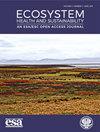鸭绿江河口浮游植物分异大小的时空分布特征
IF 3.4
2区 环境科学与生态学
Q1 ECOLOGY
引用次数: 0
摘要
浮游植物的粒度结构对贝类养殖有很大影响。本研究旨在评估2020年鸭绿江口浮游植物群落结构的时空变化,并探讨浮游植物群落结构与各种环境参数的关系。本研究采用高通量测序。结果表明:全年以纳米浮游植物为主,尤以卡洛迪纳姆(Karlodinium veneficum)居多。春季浮游植物生物量比为20:63:17,夏季为30:44:26,秋季为1:38:61,冬季为2:45:53。全年生物量最大的是甲藻门,其次是硅藻门。在空间维度(站平均)上,COD、T、SST对总浮游植物群落有正向影响,而Dep有负向影响。在时间维度(月平均)上,对浮游植物群落结构起显著控制作用的环境因子为NO2和海温。本文章由计算机程序翻译,如有差异,请以英文原文为准。
Spatiotemporal distribution of size-fractioned phytoplankton in the Yalu River Estuary, China
ABSTRACT The grain size structure of phytoplankton has great influence on shellfish culture. The present study aimed to assess the spatial and temporal variation in the phytoplankton community structure in the Yalu River Estuary and to explore the relationship between the phytoplankton community structure and various environmental parameters in 2020. High-throughput sequencing was used in this study. The results showed that nanophytoplankton, especially Karlodinium veneficum, dominated the estuary throughout the year. The biomass ratio of picophytoplankton, nanophytoplankton, and microphytoplankton were 20:63:17 in spring, 30:44:26 in summer, 1:38:61 in autumn, and 2:45:53 in winter, respectively. Meanwhile, Dinophyta had the greatest biomass throughout the year, followed by Bacillariophyta. On the spatial dimension (Station average), COD, T, SST had a positive impact on total phytoplankton communities, and Dep had a negative impact. In the time dimension (Monthly average), the environmental factor that significantly controlled the phytoplankton community structure were NO2 and SST.
求助全文
通过发布文献求助,成功后即可免费获取论文全文。
去求助
来源期刊

Ecosystem Health and Sustainability
Environmental Science-Management, Monitoring, Policy and Law
CiteScore
7.10
自引率
2.00%
发文量
40
审稿时长
22 weeks
期刊介绍:
Ecosystem Health and Sustainability publishes articles on advances in ecology and sustainability science, how global environmental change affects ecosystem health, how changes in human activities affect ecosystem conditions, and system-based approaches for applying ecological science in decision-making to promote sustainable development. Papers focus on applying ecological theory, principles, and concepts to support sustainable development, especially in regions undergoing rapid environmental change. Papers on multi-scale, integrative, and interdisciplinary studies, and on international collaborations between scientists from industrialized and industrializing countries are especially welcome.
Suitable topics for EHS include:
• Global, regional and local studies of international significance
• Impact of global or regional environmental change on natural ecosystems
• Interdisciplinary research involving integration of natural, social, and behavioral sciences
• Science and policy that promote the use of ecological sciences in decision making
• Novel or multidisciplinary approaches for solving complex ecological problems
• Multi-scale and long-term observations of ecosystem evolution
• Development of novel systems approaches or modeling and simulation techniques
• Rapid responses to emerging ecological issues.
 求助内容:
求助内容: 应助结果提醒方式:
应助结果提醒方式:


